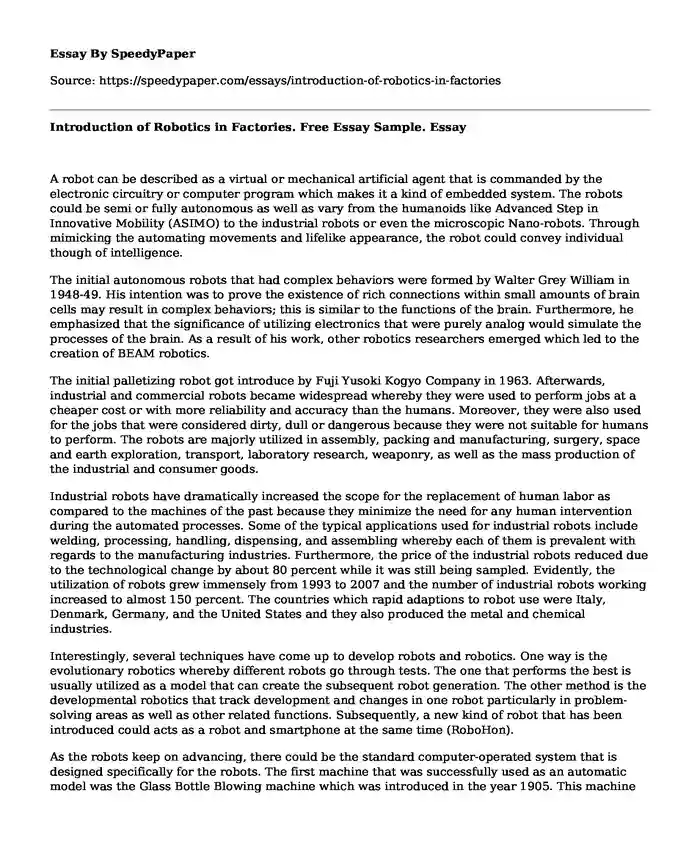
| Type of paper: | Dissertation chapter |
| Categories: | Technology Job |
| Pages: | 3 |
| Wordcount: | 786 words |
A robot can be described as a virtual or mechanical artificial agent that is commanded by the electronic circuitry or computer program which makes it a kind of embedded system. The robots could be semi or fully autonomous as well as vary from the humanoids like Advanced Step in Innovative Mobility (ASIMO) to the industrial robots or even the microscopic Nano-robots. Through mimicking the automating movements and lifelike appearance, the robot could convey individual though of intelligence.
The initial autonomous robots that had complex behaviors were formed by Walter Grey William in 1948-49. His intention was to prove the existence of rich connections within small amounts of brain cells may result in complex behaviors; this is similar to the functions of the brain. Furthermore, he emphasized that the significance of utilizing electronics that were purely analog would simulate the processes of the brain. As a result of his work, other robotics researchers emerged which led to the creation of BEAM robotics.
The initial palletizing robot got introduce by Fuji Yusoki Kogyo Company in 1963. Afterwards, industrial and commercial robots became widespread whereby they were used to perform jobs at a cheaper cost or with more reliability and accuracy than the humans. Moreover, they were also used for the jobs that were considered dirty, dull or dangerous because they were not suitable for humans to perform. The robots are majorly utilized in assembly, packing and manufacturing, surgery, space and earth exploration, transport, laboratory research, weaponry, as well as the mass production of the industrial and consumer goods.
Industrial robots have dramatically increased the scope for the replacement of human labor as compared to the machines of the past because they minimize the need for any human intervention during the automated processes. Some of the typical applications used for industrial robots include welding, processing, handling, dispensing, and assembling whereby each of them is prevalent with regards to the manufacturing industries. Furthermore, the price of the industrial robots reduced due to the technological change by about 80 percent while it was still being sampled. Evidently, the utilization of robots grew immensely from 1993 to 2007 and the number of industrial robots working increased to almost 150 percent. The countries which rapid adaptions to robot use were Italy, Denmark, Germany, and the United States and they also produced the metal and chemical industries.
Interestingly, several techniques have come up to develop robots and robotics. One way is the evolutionary robotics whereby different robots go through tests. The one that performs the best is usually utilized as a model that can create the subsequent robot generation. The other method is the developmental robotics that track development and changes in one robot particularly in problem-solving areas as well as other related functions. Subsequently, a new kind of robot that has been introduced could acts as a robot and smartphone at the same time (RoboHon).
As the robots keep on advancing, there could be the standard computer-operated system that is designed specifically for the robots. The first machine that was successfully used as an automatic model was the Glass Bottle Blowing machine which was introduced in the year 1905. This machine was operated by two men that worked 12-hour shifts; this managed to produce over 17,000 bottles each day. This is a significant difference as compared to the 2,800 bottles that are made by a six-man crew that works for an entire day. Therefore, the related cost of making the bottles through use of a machine goes down significantly in comparison with manual helpers and glassblowers.
Before automation took place, most chemicals were created in batches. For instance, in 1930, there was a widespread utilization of instruments as well as the emerging controller use: continuous production. On the other hand, during the 1840s, James Nasmyth developed self-acting machines which displaced the hand dexterity in order for them to be operated by unskilled laborers. These machine tools got automated with the Numerical Control (NC) by using a punched paper tape which existed during the 1950s. Eventually, this was modified to Computerized Numerical Control (CNC).
Currently, widespread automation is being practiced virtually in every kind of assembly and manufacturing process. Various of these larger processes entail generation of electric power, chemicals, oil refining, plastics, steel mills, fertilizer plants, truck and automobile assembly, pulp and paper mills, beverage and food processing, glass manufacturing, bottling and canning, Natural Gas Separation plants and the manufacture of several types of parts. Furthermore, the robots are particularly useful when it comes to hazardous applications such as automobile spray painting. Additionally, robots are used in assembling the electronic circuit boards. The automotive welding is also performed by robots and the automatic welders can be used in some applications like the pipelines.
Cite this page
Introduction of Robotics in Factories. Free Essay Sample.. (2017, Sep 19). Retrieved from https://speedypaper.net/essays/introduction-of-robotics-in-factories
Request Removal
If you are the original author of this essay and no longer wish to have it published on the SpeedyPaper website, please click below to request its removal:
- Social Psychology Essay Sample: Paths to Persuasion, Impression Management, Spin Doctoring and Propaganda
- Free Essay in Philosophy: Strong Objectivity and Standpoint Theory
- Essay Sample on Insight of Bullying
- Essay Sample on Consumer Health Informatics
- Reflective Essay on Plagiarism
- Essay Sample on Renting vs Buying
- Free Essay Example: About Serengeti Rules
Popular categories




